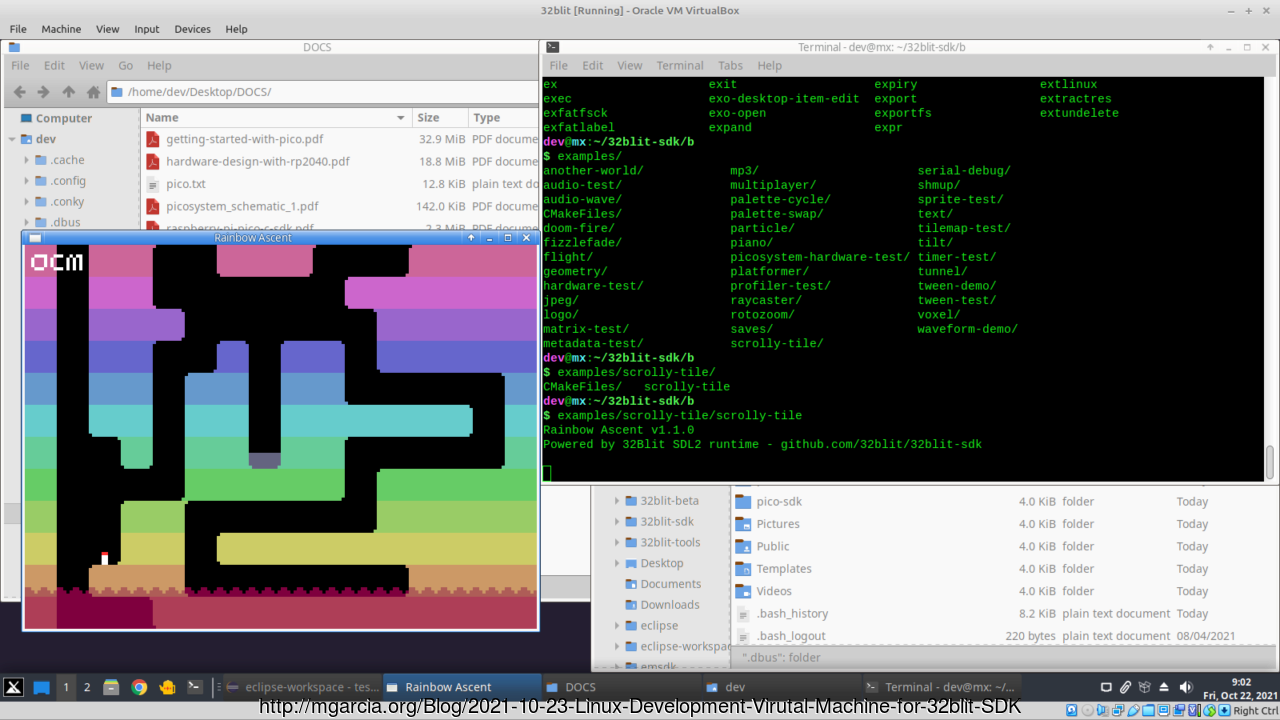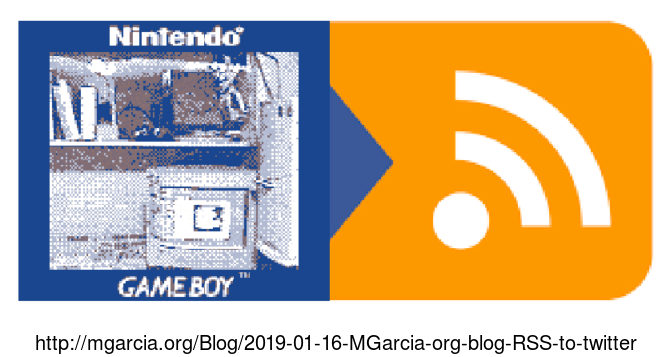Linux Development Virutal Machine for 32blit SDK
October 23, 2021, at 04:21 AM (3 comments)
Title: Linux Development Virutal Machine for 32blit SDK Author: mgarcia Date: 2021-10-23 04:21 +0200 Tags: 2021, PC, Pics, GameDev, Blog Comments: Open

Click to view original image: 224kb
Introduction
The VM is 32blit.7z, it is a 3.2 GB download and is 13.5 GB extracted.
It was created with Virtual Box 6.1, so you'll probably want to reinstall virtual box's guest tools.
Auto log in as user dev
All passwords are: dev
It's MX-21_x64, set up with Eclipse CDT C/C++ 2021-09-R and builds for the following targets:
- Linux 64bit
- Windows 64bit (wine64 is also installed)
- Emscripten (chrome browser)
- Pimoroni 32blit
- Pimoroni PicoSystem
- Pimoroni VGA Board (aka Raspberry Pi Pico reference board, you can find it in chapter 3 of Hardware Design with RP2040 along with more general info about the VGA reference board.)
To install create a new Virtual Box application without the harddrive, then extract the 32blit.vbi into that folder and add the drive to the "virtual media manager" then add the drive to your VM application, configure it similarly to the images included and it should start fine. I recommend configuring the USB devices to auto connect to the VM guest, bidirectional copy and paste and a shared folder. How to use Eclipse and build the examples for each target is described at the end.
This is my personal VM, shared in the interest of helping the community. To my knowledge, there is nothing malicious or none GNU/free software.
Use at own risk, etc.
The challenge
ETA prime, did a review of the PicoSystem and threw down a challenge to play some community made games on his next video!
A New Handheld Powered By The Same Raspberry Pi Pico Chip!
PicoSystem's limitations makes it it's strength, by focusing on small 8bit or 16bit retro games, which also makes it ideal for game jams.
PicoSystem and VGA Board are very similar, so if you choose to get a VGA Board instead, I think that should be fine.
I see the VGABoard, as a console version, of a PicoSystem.
I'm not an expert, there's a lot of noob hacks here, but to encourage others, here are my notes on setting up.
32blit is very impressive how it can target so many platforms! Sorry I wont be mentioning Mac or chrome OS's, I'm not familiar at all with them.
I'm mostly in the 32blit discord (Chat) - https://discord.gg/7qM9ftC But I can try and answer/help here to.
General noob tips
The 32blit documentation is pretty good, but I still got caught out here and there. Keep folders names simple, ie no spaces or none ASCI chars, including user name!
Make sure your .profile or .bash_profile etc can be run correctly in your window terminal before starting! Sometimes they have access issues, ie a quick fix can be:
chmod 777 $HOME/.bash_profile
If you want to build faster use:
make -j2
The number is the threads to run, the more the faster
I'm a git,cmake,arm noob, it's best to git clone each repo then to download them as zips, this is required by some, but best to do for all, IE:
git clone -b master https://github.com/raspberrypi/pico-sdk.git
Each target has it's own build folder in the 32blit-sdk (or your game) folder
ie build.stm32 build.em etc.
Here is the directory structure, I've used:
> $HOME/ >> emsdk >> pico-sdk >> 32blit-tools >> pico-extras >> pico-sdk >> gcc-arm-none-eabi-9-2020-q2-update (not required, and probably a me thing) >> .local/bin (auto generated - location of the 32blit tool) >> 32blit-sdk (was 32blit-beta, latest branch for pico devices) >> >> 32blit-sdk/ >>>>> build >>>>> build.picosystem >>>>> build.vgaboard >>>>> build.win64 >>>>> build.em >>>>> build.stm32
My setup.
I thought I would use a new linux flavor, I went with MX (debian based) and picked XFCE (and unknowingly stable).
Here are the links:
https://distrowatch.com/?newsid=11206
–Xfce (our flagship desktop) MX-21_x64, with a standard 64 bit kernel and hardware support from Debian Stable. Suitable if your PC is a few years old.
https://mxlinux.org/download-links/#Mirrors
Eclipse, my IDE of choose for over 20years now!
https://www.eclipse.org/downloads/packages/release/2021-09/r/eclipse-ide-cc-developers
I installed this to a Virtual Box image, so it's self contained, the USB devices are automatically forward to the VM.
To access the usb device from your account, enter:
sudo gpasswd -a yourusername vboxusers
log out and back in.
GNU/Linux
After install, run: sudo apt update
If VMWARE open-vm-tools should already be instaleld, don't use vmware's linux.iso. check vm tools is running: sudo /etc/init.d/open-vm-tools status
Test it by copying and pasting to and from VM, if not, installing the desktop might help: sudo apt-get install open-vm-tools-desktop reboot and test again.
Virtual Box, just insert VB tools cdrom and install.
Follow: https://github.com/32blit/32blit-sdk/blob/master/docs/Linux.md
sudo apt install git gcc g++ gdb gcc-arm-none-eabi cmake make python3 python3-pip python3-setuptools libsdl2-dev libsdl2-image-dev libsdl2-net-dev unzip
optional, handy to have installed:
sudo apt install p7zip-full p7zip-rar meld chromium-browser geany vbindiff audacity htmldoc lame imagemagick wine64 wine32
Old 2.8 gimp!
https://archive.org/details/gimp-2.8.AppImage
The OS app control keys are (see hardware-test app):
Dpad = arrow keys or WASD A = Z key B = X key X = C key Y = V key Home = 1 key Menu = 2 or ESC key Joystick = Mouse within app screen Joystick press = 3 key Tilt controls, I don't know, gamepad right analog stick maybe?
32blit tool
I found this part a bit confusing.
In your $HOME folder (not 32blit root)
https://github.com/32blit/32blit-tools
It also requires:
https://github.com/pimoroni/boilerplate-python
Run:
git clone https://github.com/32blit/32blit-tools.git
cd 32blit-tools
git clone https://github.com/pimoroni/boilerplate-python.git
cp -a boilerplate-python/* .
Next, I had issues running pip3, not in the path (of sudo possibly), again, I brought forced scripts that used pip3, replacing it with: python3 -m pip
Run:
pip3 install 32blit
or
python3 -m pip install 32blit
or to update it, run:
python3 -m pip install --upgrade 32blit
That will build tool and install the tool into ~/.local/bin and add the path to your env file setting, ie .profile
Setup and build the linux native
From: https://github.com/32blit/32blit-sdk/blob/master/docs/Linux.md
Setup it, in user root (ie ~):
git clone https://github.com/32blit/32blit-sdk.git
Building it is unnecessary, except to test the toolchain and see the demo's etc.
cd ~/32blit-sdk mkdir build cd build cmake .. -D32BLIT_DIR=$HOME/32blit-sdk make -j2
run and test the exe's
stm32 (32blit)
AKA 32blit: https://32blit.com/blog Follow: https://github.com/32blit/32blit-sdk/blob/master/docs/32Blit-Firmware.md#building--flashing-the-32blit-firmware
Make sure to have a fat32 formated SD card handy!
cd ~/32blit-sdk mkdir build.stm32 cd build.stm32 cmake .. -DCMAKE_TOOLCHAIN_FILE=$HOME/32blit-sdk/32blit.toolchain -D32BLIT_DIR=$HOME/32blit-sdk make -j2 When linking the executables, you'll see a warning like this: [ 97%] Building CXX object CMakeFiles/game.dir/assets.cpp.obj [100%] Linking CXX executable game.elf /home/dev/gcc-arm-none-eabi-9-2020-q2-update/bin/../lib/gcc/arm-none-eabi/9.3.1/../../../../arm-none-eabi/bin/ld: warning: cannot find entry symbol Reset_Handler; defaulting to 00000000900001a0 Building game.bin text data bss dec hex filename 21688 904 2280 24872 6128 /home/dev/eclipse-workspace/test/build.stm32/game.elf There are 42 section headers, starting at offset 0x988a0:
The reason for this is because games don't have a reset handler (only the firmware does).
On my debian stable, or the MX repo the gcc-arm-none-eabi package (from 2018) couldn't build the stm32. I had to "brute force it"... and downloaded the tar.bz2 file and extracted it and manually fixed up the paths in .profile PATH="$HOME/gcc-arm-none-eabi-9-2020-q2-update/bin:$PATH"
gcc-arm-none-eabi-9-2020-q2-update-x86_64-linux.tar.bz2 from https://developer.arm.com/tools-and-software/open-source-software/developer-tools/gnu-toolchain/gnu-rm/downloads
I had to specify -DPICO_TOOLCHAIN_PATH=$HOME/gcc-arm-none-eabi-9-2020-q2-update in stm32/pico cmake commands below.
TTY permissions
Before plugging in 32blit or a pico device, do this, give your user access to serial device! On linux, both devices uses: /dev/ttyACM0 https://github.com/esp8266/source-code-examples/issues/26
sudo usermod -a -G tty username
update firmware.
Updated the firmware, if it's old.
cd ~/32blit-sdk/build.stm32
Put the 32blit in DFU mode (hold X/Y and press reset) , plug the USB cable in.
32blit flash firmware/firmware.bin
or
make firmware-update.flash
next install the launcher:
32blit install launcher/launcher.blit
or
make launcher.flash
If the 32blit is disconnected while flashing, it will kill the launcher, just reflash/install as above.
I recommend copying all .blit files (including the launcher.blit) to SD card first, and installing from there, using: 32blit install filename.blit /
Install all the other demos (see bottom of Makefile for more info):
make install DEMO-NAME.flash
You now should have a working and demo loaded 32blit!
Emscripten
Follow: https://github.com/32blit/32blit-sdk/blob/master/docs/Emscripten.md
git clone https://github.com/emscripten-core/emsdk.git cd emsdk ./emsdk install latest ./emsdk activate latest source ./emsdk_env.sh make sure paths are correctly executed when a new shell/terminal is open,it should automatically run source $HOME/emsdk/emsdk_env.sh cd ~/32blit-sdk mkdir build.em cd build.em emcmake cmake .. -D32BLIT_DIR=$HOME/32blit-sdk ************* hitting 16MB default limit ************* edit CMakeCache.txt add -s TOTAL_MEMORY=67108864 to the LINKFLAGS 32MB = 33554432 64MB = 67108864 etc.. //Flags used by the linker during all build types. CMAKE_EXE_LINKER_FLAGS:STRING= -s TOTAL_MEMORY=67108864 It should automatically update the linker settings: CMakeFiles/game.dir/link.txt If not, add it to the line after em++ Looking at the link.txt file above it also lets you change the shell-file which is normally at /home/dev/32blit-sdk/32blit-sdl/emscripten-shell.html, this HTML file sets the title ************* hitting 16MB default limit ************* make -j2 (or more, takes a long time!) I like to create a script file that starts the server is helpful: #!/bin/bash python3 -m http.server Run in a terminal and CTRL C to stop it. I don't know why, but firefox doesn't like it, chrome browser works fine. The keyboard buttons (from hardware-test app): http://0.0.0.0:8000/32blit-sdk/build.em/examples/hardware-test/hardware-test.html Same as the native OS controls.
Android
I don't have much experience with Android, the little I know is old school, but I got 32blit working with ant build, not gradle.
There are two archives here:
https://archive.org/details/sdl2-32blit-Ouya-android-6-linux-development-envirnoment
SDL2-32blit-Ouya-Android6-linux-development-envirnoment.7z 1.6G
This is all the Android tools and source to build the 32blit hardwaretest demo as signed, release apk, includes source NDK and SDK used to for example, extract the Android folder to the /home/dev folder in the Linux VM, put your game in the jni/game folder, modify the android.mk file and it should just work.
Source-Code-only-no-dev-env-ouya-android-PC.7z 36.9M
This is just the source folders to build the hardwaretest apk, it's include in the above files also, it includes:
- hardwareTest - added SDL2 embedded GameControllerDB support
- ouya-android - hardwareTest for Ouya, it's very hacky, I had to replace the button presses with keyboard keys, but it works.
- newer-android - hardwareTest for Android 6, it all works as expected and runs well.
windows exe
I use: sudo apt-get install mingw-w64 Not the documented: sudo apt install gcc-mingw-w64 g++-mingw-w64 after: sudo mkdir -p /opt/local/ make it accessible: sudo chmod -R 777 /opt/local cd /opt/local and download and extract as per instructions.
in 32blit-sdk root mkdir build.win64 cd build.win64 cmake .. -DCMAKE_TOOLCHAIN_FILE=$HOME/32blit-sdk/mingw.toolchain -D32BLIT_DIR=$HOME/32blit-sdk make -j2 optionally install wine sudo apt install wine64 recommend installing wine32, also. installs as: /usr/bin/wine64-stable or just wine. test: /usr/bin/wine64-stable examples/geometry/geometry.exe
setting up PicoSystem / VGA BOARD
VGA BOARD
https://shop.pimoroni.com/products/pimoroni-pico-vga-demo-base
PicoSystem
https://shop.pimoroni.com/products/picosystem
Both being based on the RP Pico, require the same source code, nothing is built in these folders.
https://github.com/raspberrypi/pico-sdk
Also read the PDF section 2.1. Get the SDK and examples
https://datasheets.raspberrypi.com/pico/getting-started-with-pico.pdf
In your $HOME folder (not 32blit root) git clone -b master https://github.com/raspberrypi/pico-sdk.git cd pico-sdk git submodule update --init cd ~ git clone -b master https://github.com/raspberrypi/pico-extras.git cd into ~/32blit-sdk Follow: https://github.com/32blit/32blit-sdk/blob/master/docs/pico.md
PicoSystem Bleeding edge!
Note: below is based on old info, using the 32blit-sdk as normal. Docs are here: https://github.com/32blit/32blit-sdk/blob/master/docs/pico.md
Both devices are under heavy development currently!
The newer branches of 32blit-sdk has better performance and feature support ie USB support for VGA board, it's called 32blit-beta instead of 32blit-sdk. But the two can be used together by using the beta folder with pico devices, ie:
cd $HOME
git clone -b pico-all-the-boards --single-branch https://github.com/Daft-Freak/32blit-beta.git
This branch requires the latest tinyUSB
cd $HOME/pico-sdk/lib/
mv tinyusb tinyusb.orig
git clone https://github.com/hathach/tinyusb
The new source code is referenced from the 32blit-sdk root builds, ie:
In 32blit-sdk root
mkdir build.picosystem
cd build.picosystem
I dev in linux and test (release build) on picosystem with:
cmake .. -DCMAKE_TOOLCHAIN_FILE=$HOME/32blit-sdk/pico.toolchain -D32BLIT_DIR=$HOME/32blit-sdk -DPICO_SDK_PATH=$HOME/pico-sdk -DPICO_EXTRAS_PATH=$HOME/pico-extras -DPICO_BOARD=pimoroni_picosystem -DCMAKE_BUILD_TYPE=Release
make -j2
The VGA board is similar as above, but with -DPICO_BOARD=vgaboard instead of -DPICO_BOARD=pimoroni_picosystem
repeat for vgaboard into new build folder, ie:
in 32blit-sdk root
mkdir build.vgaboard
cd build.vgaboard
mkdir build.vgaboard
cd build.vgaboard
cmake .. -D32BLIT_DIR=$HOME/32blit-sdk -DPICO_SDK_PATH=$HOME/pico-sdk -DPICO_EXTRAS_PATH=$HOME/pico-extras -DPICO_BOARD=vgaboard
make -j2
Pico, VGA & 32blit USB TTY printing
Make use TTY permissions is correct.
32blit can printf to the TTY terminal using:
blit::debugf("Play Sound \n");
Text is output via USB using the TTY, so install one, ie:
sudo apt-get install putty cu minicom screen
I found screen to work the easiest (no params)
display text output screen:
screen /dev/ttyACM0 115200
log file:
screen -L /dev/ttyACM0 115200
make; 32blit install game.blit ; screen -L /dev/ttyACM0 115200
In my experience, the logging can sometimes lock the 32blit and the terminal!
Alternatively, a simple cat of the tty device, also works fine:
cat /dev/ttyACM0
new project
read https://github.com/32blit/32blit-boilerplate/
cd into the folder you want to start a in project, ie:
cd $HOME/eclipse-workspace
git clone https://github.com/32blit/32blit-boilerplate.git PROJECT_NAME
cd PROJECT_NAME
next you have to build it to set the executable, same process as above:
mkdir build
cd build
cmake .. -D32BLIT_DIR=$HOME/32blit-sdk -DCMAKE_BUILD_TYPE=Debug
make -j2
run it: ./game
You can create a new build folder for a release target, etc
I use a new release build directory, just run the same cmake command but with: -DCMAKE_BUILD_TYPE=Release
If you are targeting linux, I would suggest building with standard libraries statically linked... add the follow to the top (after project(32blit)) of 32blit-sdk/CMakeLists.txt:
project(32blit)
IF(CMAKE_SYSTEM_NAME MATCHES "Linux")
set(CMAKE_SHARED_LINKER_FLAGS "-static-libgcc -static-libstdc++ -static")
LINK_DIRECTORIES(additions/libstdc)
ADD_DEFINITIONS(-static-libgcc)
SET(CMAKE_CXX_LINK_EXECUTABLE “${CMAKE_CXX_LINK_EXECUTABLE} -static-libgcc”)
MESSAGE(DEBUG "Linux os: ${outOS}")
ELSEIF(CMAKE_SYSTEM_NAME MATCHES "Windows")
MESSAGE(DEBUG "Windows")
ELSE()
MESSAGE(DEBUG "No OS detected!")
ENDIF(CMAKE_SYSTEM_NAME MATCHES "Linux")
How To Use Eclipse
I'm sure there's better ways to work with eclipse and cmake projects, but here's how I do it:
import the PROJECT_NAME folder as an existing code as makefile project.
right click build->game -> run as -> local C++ app - double click C/C++ app.
click menu run -> run configuration, click 'build configuration' append build/ to build director: ie ${workspace_loc/PROJECT_NAME:}/build/ click apply
Now if you change game.cpp it'll compile first before running.
Next, set the default header full paths for include SDL2/32blit-sdl/32blit.
right click main project -> properties -> C/C++ general -> Paths and symbols, add to include directories individual, tick add to all config and languages:
/opt/local/x86_64-w64-mingw32/include/SDL2
/home/dev/32blit-sdk/32blit-sdl
/home/dev/32blit-sdk/32blit
Note: change dev to your username.
click apply.
right click main project, index -> rebuild
CTRL left mouse click a 32blit classes/function and you should drill down into it, ect.
To debug, set a break point and click debug icon
To target other platforms, create a new build folder and use the same cmake parameters as above when building the 32blit-sdk examples.
IE:
cd PROJECT_NAME
mkdir build.em
cd build.em
emcmake cmake .. -D32BLIT_DIR=$HOME/32blit-sdk
make
python3 -m http.server
now, launch chrome browser, click game.html, close browser
ctrl -c to cancel server.
My 32blit Unboxing
Originally from: 2020 28th March - Warning, it's uses Text To Speech!
32Blit, A modern day Net Yaroze, Retro hardware game development
What to do next?
Using Eclipse (or your favorite IDE), import the 32blit examples, to look through the source code.
In Eclipse, the easy way is to create a new Project, by:
File -> New -> Project
Select "Makefile Project with Existing Code", next.
Click brows and select ~/32blit-sdk/examples
Next, pick Linux GCC and click finish.
Now, set the default header full paths for include SDL2/32blit-sdl/32blit as explained prior.
You'll have all the examples ready to read, however, you can't launch, compile or debug them.
32blit API Documentation
Although, there's not much documentation in 32blit API, it's included here, in a separate file.
But to recreate the doxygen doc's run:
sudo apt update && sudo apt install doxygen graphviz python3-setuptools
cd $HOME/32blit-sdk/32blit && doxygen doxygen.conf
Fix the scroll bars being too small
https://forum.manjaro.org/t/enlarge-scroll-bar-width-how-to/47579
Change text size
MX Tweak - appearance (button bot right) - fonts tab - default font.
File browser shortcuts
Create shortcuts on the file browser, right click and send to -> side pane.
Launch exe's
https://askubuntu.com/questions/876567/ask-before-running-script-in-thunar
#!/bin/bash
zenity --question --text="What to do with the executable file '$1'?" \
--ok-label=Run \
--cancel-label=Edit
case $? in
0)xfce4-terminal -e "$1"
;;
1)geany $1
;;
esac
[Desktop Entry]
Type=Application
Name=Edit-or-run
Icon=geany
Categories=Utility;
MimeType=application/x-sh;application/x-executable;
Exec=bash -c '/home/dev/editorrun.sh %f'
Updating 32blit SDK
The VM image is pretty old now, and require new sources to be updated. Start with building the 32blit tool and the 32blit SDK for each target... it should just work!
More...
In general, if you have any windows issue search it with Xfce.
If you have a file browser issue search it with thunar or MX linux.
I like having all my tools in the VM, so I install gimp etc.



3 comments on "Linux Development Virutal Machine for 32blit SDK"